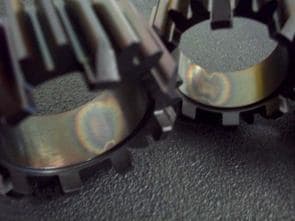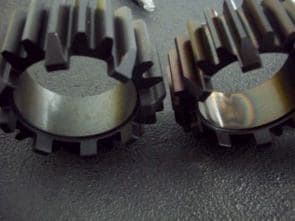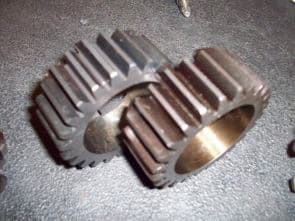
Curated with aloha by
Ted Mooney, P.E. RET

The authoritative public forum
for Metal Finishing 1989-2025

-----
Can Racking During Black Oxide Process Cause Thermal Discoloration Appearance?
We have recently received several 4340 gears from a supplier that appear to have been heated and discolored on the ID of a honed bore in an oval shape. The supplier claims that the discoloration is due to the racking during the black oxide process and has always been there, while my tech says he has never seen this before. It seems to make sense to me based upon the shape, although I don't know what the racks look like and am not experienced with the black oxide process (although I am aware of the process steps). Can the racking prevent the black oxide formation and make it appear to have been locally heated?
Terry DeKoninckEngineer - Clarkston, Michigan, USA
April 14, 2009
I think I know what you are you are trying to say. What you are seeing is areas that did not blue properly. I see it all the time when I'm bluing firearms. A lot of gunsmiths have spilled a lot of good whiskey arguing what actually causes this condition. Some claim that the bluing solution has to circulate to work properly. I generally chalk it up being lazy. Parts that rest on racks or on the bottom of the tank will not take a blue where contact is made. The reason I suppose is probably the rack or the bottom of the tank acts as a heat sink of sorts. The simple solution to the problem is to suspend the parts with stove pipe wire and move the parts around in the tank. Mind you the guy that's bluing those gears probably has a little brother sitting on a gear hobber and punches out a gazzillian gears a day. I don't think you could really pay me enough to blue a gazzllian gears a day. Bluing is one of the crappyist jobs in the world. I don't think even Mike Rowe would care to do it ;o)

Rod Henrickson
gunsmith - Edmonton, Alberta, Canada
April 20, 2009
Rod,
Thanks for the response. I have pics of the affected part that I'd like to share if anyone is interested in viewing them and commenting. Thanks,
Terry



- Clarkston, Michigan
April 24, 2009
Yup, just as your supplier told you. That is the area where the part was hung on the tree or pipe that was used to hold the parts as they were suspended in the tanks. As stated there are two schools of thought amongst gunsmiths. The first is that there is not proper circulation of solution in the area where the contact takes place and that area does not blue. Or second, the area that contacts the part acts as a heat sink and does not let that area get hot enough to take a blue. It's probably a combination of the two. The solution to the problem is to pull the parts out once or twice during the bluing and rotate the parts. The problem with the solution is that most machine shops now use CNC machines and the cheapest labor they can find so that they can undercut one another. The machining industry has gotten so cut throat over the last few years that they just may not to be able to do something which for the most part is simply cosmetic, to the same standards as they used to. Most gears like the ones in your photos run in oil or grease all their lives so the bluing is only there to make them look pretty. They could just as easily dip them in Cosmoline or grease to protect them in storage. I wouldn't worry about the discoloration, it won't affect the way the part works or lasts at all and once it is installed the customer will never see it. To rectify the problem will only increase the price of the parts. Nothing more. ;o)

Rod Henrickson
gunsmith - Edmonton, Alberta, Canada
April 29, 2009
Terry
I don't know a thing about bluing but the discoloration looks like it was formed from an air pocket. I have seen air pockets form in plating operations that seem to defy logic. If the surface was not clean at immersion, an air bubble is possible.
- Colorado Springs, Colorado
April 30, 2009
Q, A, or Comment on THIS thread -or- Start a NEW Thread